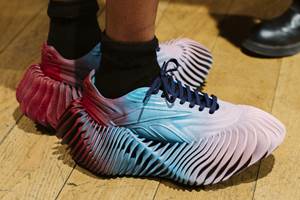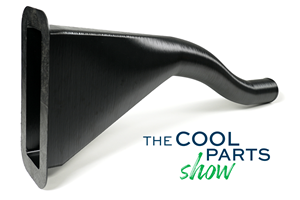Video: 3D Printed Hand Tools in Action on Pella Corporation Factory Tour
Examples include an invention for quickly installing window and door weather stripping, a fitting for giving the proper angle to a nail gun, and a clip for which the color is an important feature.
Window and door production by Pella Corporation is a high-volume, high-variability process. Many steps are manual because this is the most effective way to accommodate different products for different customers continually coming down the line. Additive manufacturing is an invaluable aid to this work because engineered hand tools tailored to Pella’s operations assure that manufacturing steps are performed quickly and repeatably. On a tour of the company’s headquarters factory in Pella, Iowa, I saw many of these 3D printed work aids in action, shown in the video above. The weather stripping tool is widely used in the company’s processes, and my favorite might be the fitting that assures exactly the right nail gun angle.
Related
- Additive manufacturing also plays a role in product development that should not be underappreciated. How 3D printing helps Pella iterate quickly for fast speed to market (video).
- What happens when the effort to advance additive manufacturing succeeds? That is Pella Corporation’s story. AM delivers on several different promises simultaneously for Pella. The challenge now is to manage demand.
Transcript
Pella Corporation is a pretty amazing user of 3D printing. Amazing for the clever simplicity of tools it creates through 3D printing to do its work better and faster.
Pella makes windows and doors. If you are a homeowner, you might know this brand. I recently visited Pella’s headquarters facility in Pella, Iowa.
This facility has 3D printing resources including a print farm mostly used for prototyping and production of low-quantity parts. But then there is also essentially an engineering tool room using fused filament fabrication 3D printers from 3ntr and Markforged to make tools Pella team members need. Window and door production includes manual steps that have to be performed precisely and fast, and Pella pays careful attention to how 3D printing can help.
On my tour through the production facility, here are just a few examples I saw.
First example is the simplest. A 3D printed drill guide allows for fast, precise placement of holes. A polymer 3D printed drill guide is lightweight compared to a metal guide and easier to handle, and reinforced polymer material creates a guide durable enough for production use.
Now look at this nail gun fitting. Attaching an inner piece around the frame that helps seal the glass pane requires the nail to go in at a particular angle. In the past it has required some finesse, and finesse slows the pace and contributes to error. This fitting is the simple solution that makes everything go faster. It holds the nail gun at exactly the right angle.
This pry tool is used to insert shims that secure the glass pane. It is 3D printed, but it’s an example of using 3D printing where it makes the most sense. When the entire tool was polymer, the handle was the point of failure. After long-term use as a lever, the handle would eventually snap. So in this design, the blade remains polymer for the sake of soft contact with the glass, but it is bolted to a machined metal handle.
And here is a purpose-designed hand tool. It is used to install weather stripping. Pella uses so many of these, at various production facilities, that it mass produced these on its print farm. This tool was made on a Bambu 3D printer. You can see here how it does the job quickly. A guide surface follows the face of the window so these rollers can press the weather stripping into place.
Here is one more mass-produced tool for internal production, also made on the print farm. 3D printers from Creality produce this clip that temporarily fastens onto the window to protect the weather stripping during production. Here, one design innovation over time was the switch to a different color filament. Early versions of this clip used to be black. But the windows are black — it was too easy to ship these tools with the window. So now, the easy fix: the clips are 3D printed orange instead.
Related Content
Concept Sneaker Boasts One-Piece 3D Printed TPU Construction
The Reebok x Botter Concept Sneaker Engineered by HP premiered at Paris Fashion Week, hinting at manufacturing possibilities for the future of footwear.
Read More6 Trends in Additive Manufacturing Technology at IMTS 2024
3D printers are getting bigger, faster and smarter. But don’t overlook the other equipment that the AM workflow requires, nor the value of finding the right supplier.
Read More3D Printed Spine Implants Made From PEEK Now in Production
Medical device manufacturer Curiteva is producing two families of spinal implants using a proprietary process for 3D printing porous polyether ether ketone (PEEK).
Read MoreAircraft Ducts 3D Printed in Composite Instead of Metal: The Cool Parts Show #68
Eaton’s new reinforced PEKK, tailored to aircraft applications, provides a cheaper and faster way to make ducts compared to formed aluminum.
Read MoreRead Next
When Advocacy Leads to Adoption: How Pella Applies (and Manages) AM Capacity
The window and door maker offers a picture of successful, widespread 3D printing adoption across the different needs of a manufacturing organization. The outreach and education effort worked. Now, here is the next phase.
Read MoreVideo: AM for Product Development at Pella Corporation
Speed to market is a critical advantage 3D printing can enable. For its new product innovations, Pella iterates quickly using prototypes and tooling produced via AM.
Read MoreProfilometry-Based Indentation Plastometry (PIP) as an Alternative to Standard Tensile Testing
UK-based Plastometrex offers a benchtop testing device utilizing PIP to quickly and easily analyze the yield strength, tensile strength and uniform elongation of samples and even printed parts. The solution is particularly useful for additive manufacturing.
Read More




















